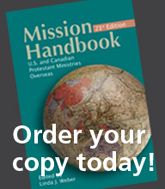|
|
WebMiss10-07-94 |
|
|
Mission
Handbook, 21st Edition U.S. and Canadian Protestant Ministries
Overseas Linda
J. Weber, ed. Evangelism
and Missions Information Service (EMIS), 2010, 624 pp. ISBN 978-1-879089-51-8 |
|
Surprisingly few people know about this
encyclopedia of mission organizations.
Occasionally I receive questions about what organizations work in a
particular country or do certain kinds of ministry or what I know about an
agency or how to get in touch with a particular mission organization. This is where I go for the answers. In the 60-page Introduction Scott Moreau provides
an analysis of the information. The
bulk of the information is for the year 2008.
Numbers and trends are
helpful, but don’t jump to conclusions.
Moreau’s discussion clarifies the reality behind the numbers. This book reports on 800 US mission organizations
(vs. 700 in 2005) and 166 in Canada. The total number of full-time
missionaries serving overseas includes
In addition there are an unknown number of
Christian professionals sent by organizations that do not want to be labeled
as “mission” organizations. There are
uncounted individuals sent and supported by local mega-churches. And there are uncounted Christians serving
as business people or entrepreneurs not reporting to any Protestant
organization. (35) 101 of the agencies were founded after 1974, about
15% of the total, mostly focused on short-term mission work. They have added only 0.5% to the long-term
workers. The number of US long term workers has grown
steadily but slowly since 1996, with the exception of a dip in 2005. The number of non-US citizens working for mission
organizations has gone from 30,000 in 1996 to 92,000 in 2008. The large majority work in their own
country and the extent to which they are working cross-culturally is not
known. Tentmakers are up 73% from 1934 (in 2005) to 3354
(in 2008). And of course there are
many who are not included in the numbers from agencies. Short-term (two-week)
workers sent by U.S. agencies (41,000) is down sharply. [But estimates
of the total number reach 1.5 million, mostly sent by local churches.] Income for overseas ministries in 2008: $5.7
billion. The income for US based
mission work has increased each year since 1996. An apparent dip in 2008 resulted from 5
agencies (still operating) that reported $0 income in 2008! [Not sure
why] The 2008 survey added five new options to the
list of activities: Business as Mission, Children at Risk, HIV/Aids, Sports
Program Ministry, and Trafficking/Slavery Issues. Each agency is asked to identify one activity
(primary activity) they most commonly associate with their organization from
the following list:
56.4% of the agencies list Evangelism and
Discipleship as their primary activity (down by 6% from 1998). Relief and Development is up by 4.65%. Agencies haven’t changed their primary
activity. But the ratio has changed because
of the primary activities of the 100 new agencies added to the Handbook. Organizations focusing on Evangelism and
Discipleship receive 47.5% of the overseas budget and 85-90% of the full-time
workers. The largest investment in full-time personnel is
in Asian countries, (more than 60,000).
The Middle East, by contrast, receives fewer than 2000 workers. Agencies continue to shift workers toward the
10/40 Window. These countries receive
about 22% of US workers and 54% of non-US full-time workers (It isn’t known
how many of these are working with the unreached.) Using David Barrett’s terminology of Worlds A, B,
and C, about 5% of full-time workers are listed in World A. However another 8.9% of full-time workers do
not specify their assignments – probably because they are in such countries. The total could be > 14%. Over half the full-time workers are in World A or
World B countries, so there is significant focus on the unreached. (64-5)
|
|
* * * * * *
Your
comments and book recommendations are welcome.
